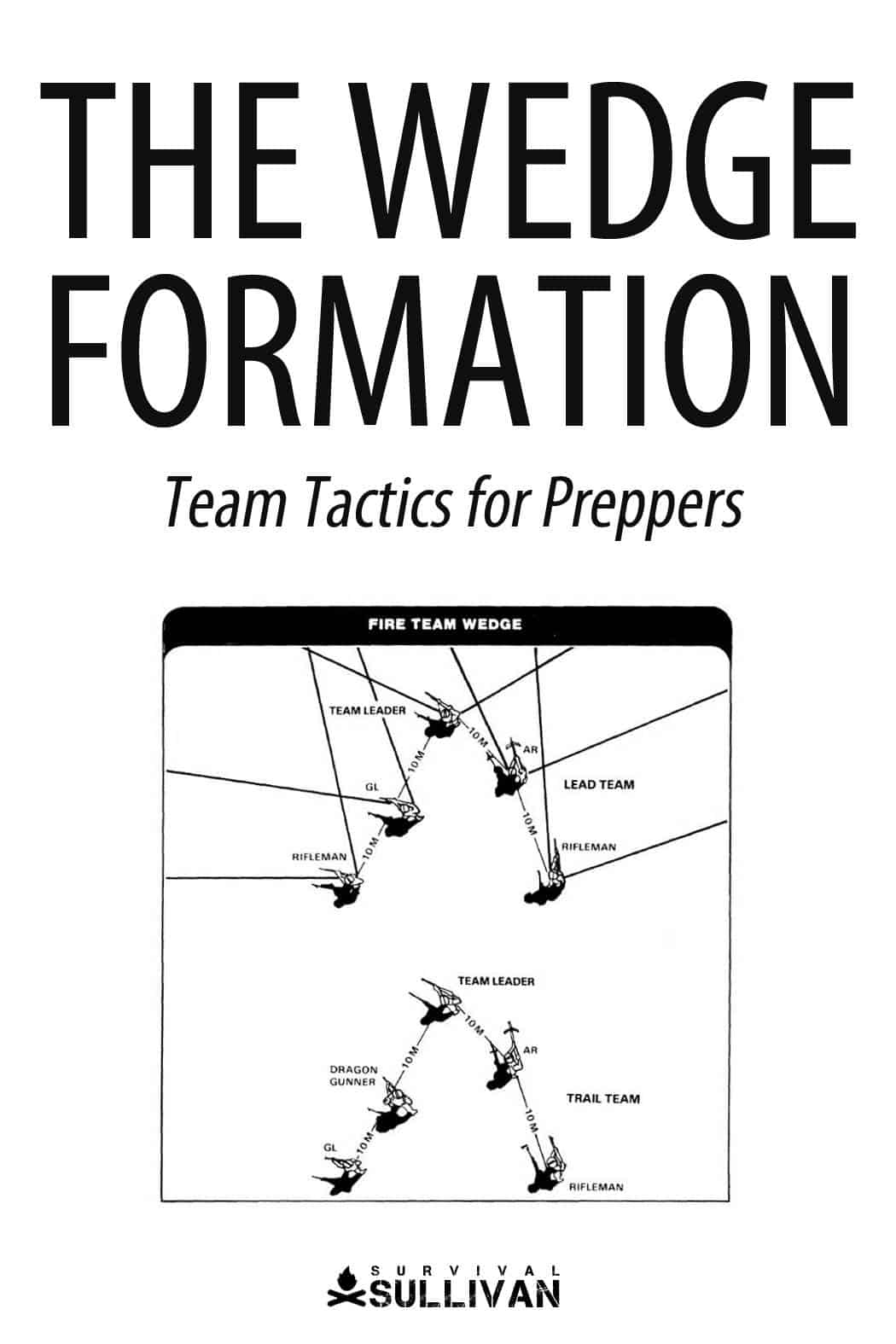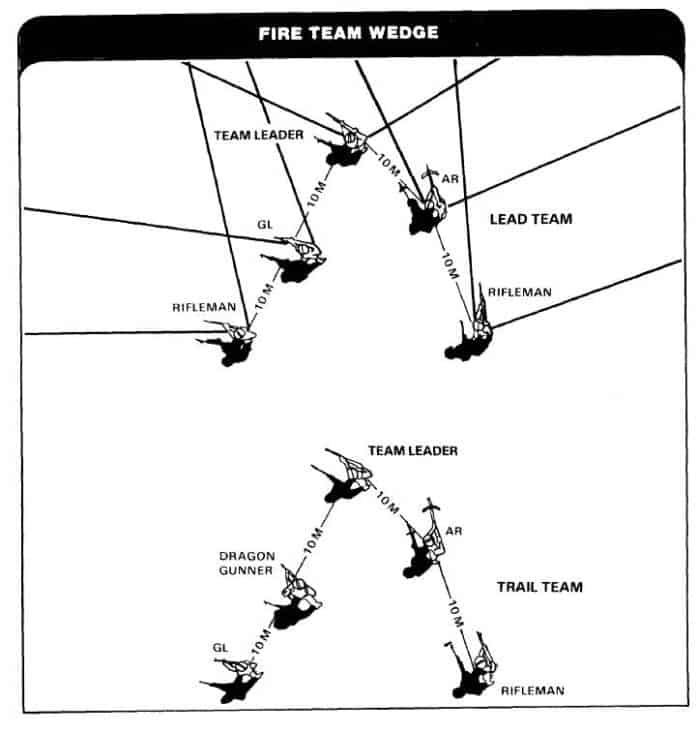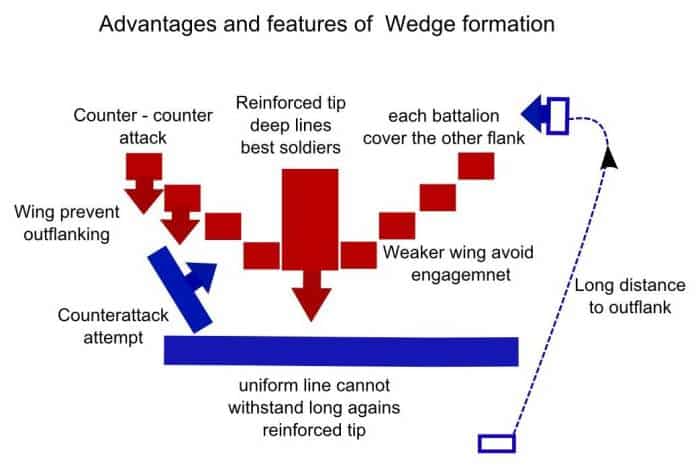
Many preppers have grand ambitions of surviving as part of a group, but comparatively few obtain the education, and then put in the work to develop group teamwork skills to the level that they should be in order to increase their effectiveness and survivability.
It is teamwork that makes the difference between being part of a barely cohesive gaggle of refugees or an organized, practiced and effective team of survivors taking on the tough times in stride.

As part of our ongoing series on team tactics for preppers, we will be exploring in greater detail on-foot procedures and tactics that we initially covered in my primer on the same.
Today will be looking at one of the most versatile, adaptable and useful formations for on-foot movement as part of a team: the wedge formation.
You don’t have to be part of a prowling, growling and snake-eating infantry platoon or Special Forces unit to have a use for and benefit from formation movement. These are procedures that should be in every prepper’s toolbox. Read on for the details.
Wedge Formation Essentials
If you are unversed in the basics of on-foot movement as part of a team, you will likely encounter some terms and other references that are unfamiliar to you. Make sure you check out my first article in this series for a primer that will bring you up to speed.
If you have already developed tactics and procedures for your apocalypse-tackling team learning formation fundamentals might just be the best next step for you, especially if you plan on patrolling in a fixed area as part of your defense plan for a bug-in response.
What is the point of formations? A better question to begin with is why should you care about how you move as part of a group, and how you orient yourself in relation to your teammates while moving together?
Consider that the threats of the post-SHTF world will be entirely similar to the threats that you might face in a conflict zone and the idea will start to make more sense. Just like a soldier or other fighter moving on or around a battlefield, you will face threats both known and unknown.
People will want to kill you in order to take what you have, because they feel threatened by you, or just because they are evil and want to kill for the sheer, bloodthirsty joy of the slaughter. Sometimes a place just ain’t big enough for both camps.
You don’t need me to tell you that your fellow man will be one of the biggest and most perennial threats in the post-collapse society.
Considering that you and your group will probably be significantly inferior in numbers to larger bands of criminal malcontents or other marauding survivors, you’re going to need every advantage you can get when moving and working in this new and scary world.
You’ll need to maximize security, maximize stealth and also maximize your ability to operate with your teammates as a functional unit that is greater than the sum of its parts.
Only intelligent use of formations will enable all of the above, and among them the wedge formation is one of the best all around. That means it is one that you should learn to use, love and adapt as part of your standard movement procedures.
Wedge Formation Details
The wedge formation looks just like a formation of geese flying through the air, or you might imagine it as an arrowhead doing the same, with a narrow point at the head of the formation consisting of the team leader or scout (pointman) with the rest of the team trailing off behind them to either side.
The result is a V-shape with the point of the “V” forming the front of the formation at the direction of travel.
Note that like most formations the team leader should always be near the front of the formation in order to better direct the entirety of the team. At the very least, the team will be able to see the team leader and do as he does; that is the point!
As always spacing is dependent upon terrain, but ideally spacing should be at least 10 meters between each team member and preferably 20.
Because the wedge is wider than it is deep, it is best used in terrain that can accommodate it. Tight confines like narrow streets, a warren of alleyways, craggy crevasses and other similarly cramped places make the wedge a non-starter or difficult to use at best.
The best attributes of the wedge are that it offers a solid foundation for many types of movements, a reasonable amount of control for the team leader, and excellent all around security.
A considerable amount of firepower can be directed instantly to the front or either side with little concern for basically competent team members shooting each-other, and engagements to the rear even for a small team can be accomplished easily with a little practice, necessitating only a 180 degree turn for members on the flanks of the wedge.
Only those team members near the front of the formation may have to reposition in order to bring their guns to bear.
You should use the wedge formation anytime you have a reasonable concern for security but no definitive confirmation of a threat in a given area. This assumes the terrain permits it, and you have no other pressing concerns like a requirement for maximum speed or maximum control of a larger group.
The wedge is adaptable for use by small teams and large teams, or multiple smaller teams working in tandem, but as the formation grows larger, the wedge should be modified for maximum control and effectiveness.
Remember: As with any formation the wedge should not be “set in stone” once you push off from your home, camp, base or wherever. Formations are, or rather should be, in a state of flux, changing and adapting as terrain and other circumstances dictate.
Just because the wedge is a good and adaptable formation does not mean you must stick to it come hell or high water if it isn’t working well.

Pros and Cons
Below are some fast facts and other considerations concerning the wedge formation. You and your team should study and understand them so you can choose the right formation for the task at hand.
✅ Pro – The wedge formation offers solid control for the team leader, since he is near the front of the formation if not at the very front the rest of the team should be able to see him more or less at all times from either side.
Since the default directive for all team members in absence of a specific directive from the team leader is “follow the team leader”, this makes the TL’s job a little easier, as he should not have to be constantly shepherding the rest of the team.
✅ Pro – Even when utilizing the wedge formation for a larger team with significant spread between each member, this is an easy formation to maintain.
Each member will have at least one and probably more team members in sight ahead of them, translating into strong coherency when it comes to direction, speed and posture of the team.
✅ Pro – The wedge formation reduces the vulnerability of the team to attack from the front and sides.
Team members on the edges of the formation can serve as flank protection, while the entirety of the team has excellent visibility to the front, increasing the chances that any threat lying in wait will be detected before an ambush is sprung.
Additionally, everyone in the formation can easily shoot to the front with very little fear of striking other teammates, while the majority of the formation can shoot to either side with the same efficacy.
❌ Con – As mentioned above the wedge formation is only suitable in settings and terrain that will allow the team to fan out laterally somewhat, while still allowing team members to maintain a visual on the next man in the formation.
In instances where terrain, visibility or other factors would significantly compress the wedge its advantages will start to shrink and another formation should be chosen in the interim.
❌ Con – A properly conducted attack can force team members on the far side of the formation to shoot between or past teammates near to the attackers if they want to meaningfully contribute to defense of the team.
This can be risky and highly problematic if team members are poorly trained or disciplined. This can be mitigated somewhat if team members opposite the attackers move to flank or reposition before responding, but this can result in additional control issues.
Conclusion
The wedge formation is an excellent and highly adaptable formation for small to intermediate sized teams. With some modification, it also lends itself to multi team movement, or employment with larger teams.
The wedge formation is at its best so long as the terrain and conditions allow nominal spread between team members, but it starts to falter on cramped terrain, or if conditions impair visibility.
You’ll definitely want to incorporate the wedge as one of your go-to formations with your team.

The post The Wedge Formation – Team Tactics for Preppers appeared first on Survival Sullivan.
https://ift.tt/2PAOXRU
via Survival Sullivan https://ift.tt/3uoppXJ
April 7, 2021 at 06:50AM

0 Comments